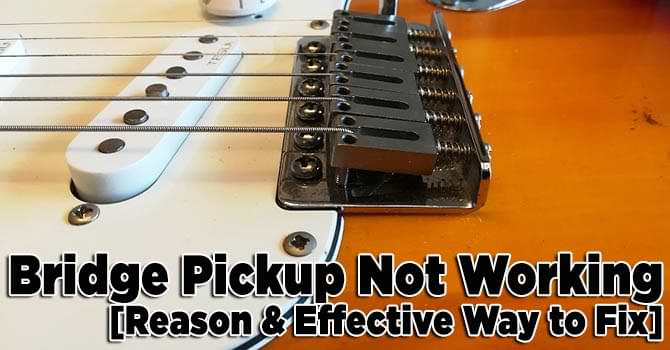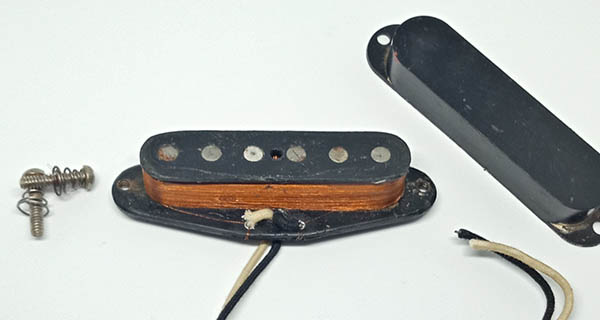Bridge Pickup Not Working [Reason & 9 Way to Fix]
As a guitarist or musician, there’s nothing more frustrating than encountering technical issues with your instrument, especially when the trusty bridge pickup fails to produce any sound. The bridge pickup plays a crucial role in delivering bright, cutting tones and is often the preferred choice for lead playing and rock genres. When it ceases to function, it can hamper your ability to create the music you like.
Discover common reasons and effective troubleshooting steps for fixing a non-functional bridge pickup. Restore your guitar’s tones and musical potential with our guide. Let’s get started!

There could be several reasons why a bridge pickup on a guitar or other musical instrument might not be working. Here are some common causes:
# Table of Contents =>
- 1 Reason & Solved: Bridge Pickup Not Working –
- 1.1 a) Wiring Issues:
- 1.2 b) Faulty Pickup:
- 1.3 c) Switch or Selector Issues:
- 1.4 d) Volume or Tone Potentiometer Problems:
- 1.5 e) Battery-Operated Pickup:
- 1.6 f) Grounding Issues:
- 1.7 g) Jack & Cable Problems:
- 1.8 How to Fix Bridge Pickup Problem:
- 1.8.1 a) Gather the Necessary Tools:
- 1.8.2 b) Inspect the Wiring:
- 1.8.3 c) Test the Pickup:
- 1.8.4 d) Check the Selector Switch and Potentiometers:
- 1.8.5 e) Battery-Powered Pickup (if applicable):
- 1.8.6 f) Grounding Check:
- 1.8.7 g) Test with Different Equipment:
- 1.8.8 h) Swap Pickups (if possible):
- 1.8.9 i) Consult a Technician:
Reason & Solved: Bridge Pickup Not Working –
a) Wiring Issues:

Wiring problems are the most common cause of a non-functional bridge pickup This could be a loose or unplugged wire, a defective weld joint, or a broken wire. Over time, welding connections may become weak, especially if the instrument has experienced heavy use or physical stress.
b) Faulty Pickup:

Sometimes, the pickup itself can be faulty or damaged. If the pickup’s internal components or coil is damaged or if the coil is broken, no sound will be produced. The presence of manufacturing defects, excessive heat, or physical damage can cause this to occur.
c) Switch or Selector Issues:
If your guitar has a pickup selector switch, it might be faulty or dirty. A malfunctioning switch can prevent the bridge pickup from engaging properly.
d) Volume or Tone Potentiometer Problems:
The volume and tone knobs (potentiometers) on the guitar may cause issues if they are dirty, worn out, or damaged. A faulty potentiometer can result in a loss of signal or irregular volume control.
e) Battery-Operated Pickup:

In some guitars or basses with active pickups, a dead or weak battery can cause the bridge pickup to stop working. Active pickups require power to function properly.
f) Grounding Issues:
Poor grounding can lead to unwanted noise or a complete loss of signal from the bridge pickup. This is more common in guitars with multiple pickups and complex wiring configurations.
g) Jack & Cable Problems:

Occasionally, the issue may not be with the pickup itself, but with the output jack or the cable being used. A loose or damaged jack can disrupt the signal flow and cause the bridge pickup to appear non-functional.
Troubleshooting steps you can take to identify the specific issue:
i) Visual Inspection: Check the wiring and connections around the bridge pickup for any loose, disconnected, or damaged wires.
ii) Test with Another Cable and Amp: Try a different cable and amplifier to ensure that the problem isn’t related to external gear.
iii) Swap Pickups: If you have multiple pickups on your instrument, you can swap the bridge pickup with another one to see if the issue persists. This will help determine if the problem lies with the pickup itself.
iv) Check Battery (if applicable): If your guitar has active pickups, verify the battery’s charge or try replacing it with a new one.
v) Clean Potentiometers and Switches: If the issue seems related to the volume or tone controls, try cleaning the potentiometers or switches with contact cleaner to remove any dirt or debris.
How to Fix Bridge Pickup Problem:
To fix a non-working bridge pickup on a guitar or any musical instrument effectively, follow these steps:
a) Gather the Necessary Tools:
- Screwdrivers (usually Phillips head) to open the guitar’s control cavity.
- Soldering iron and solder for re-soldering any loose connections.
- Multimeter (optional) to test the continuity of wires and components.
- Contact cleaner (for potentiometers and switches) to remove any dirt or debris.
b) Inspect the Wiring:
- Carefully open the control cavity or back panel of the guitar to access the electronics.
- Examine the wiring around the bridge pickup for any loose, disconnected, or damaged wires.
- Re-solder any loose or broken connections, ensuring a strong and clean solder joint.
c) Test the Pickup:
- Use a multimeter (if available) to check the continuity of the pickup’s connections and coil.
- If the pickup is completely dead, the multimeter will not register any continuity across its terminals, indicating a faulty pickup that needs replacement.
d) Check the Selector Switch and Potentiometers:
- Inspect the pickup selector switch and clean it with contact cleaner if it feels sticky or dirty.
- Test the volume and tone potentiometers by turning them while plugging in the guitar. If they produce scratchy or intermittent sound, they might need cleaning or replacement.
e) Battery-Powered Pickup (if applicable):
- For guitars with active pickups, verify the battery’s charge or try replacing it with a new one.
- Some active pickup systems have a preamp that may also require inspection or replacement.
f) Grounding Check:
- Ensure that all grounding wires are securely connected to their proper locations to avoid unwanted noise or signal loss.
g) Test with Different Equipment:
- Plug the guitar into a different amplifier with a new cable to rule out external equipment issues.
h) Swap Pickups (if possible):
- If you have multiple pickups in your guitar, you can try swapping the bridge pickup with another one to see if the problem remains isolated to the pickup itself.
i) Consult a Technician:
- If you are not confident in your electronics and soldering skills, or if the issue remains unresolved, it’s best to consult a qualified guitar technician.
In conclusion, while a bridge pickup not working on your guitar can be frustrating. Remember to be patient and methodical while troubleshooting and fixing the bridge pickup issue. Soldering should be done with care to avoid damaging other components or causing additional problems. Even you face with more intricate challenges, don’t hesitate to seek assistance from a qualified guitar technician.
Maintaining your instrument in optimal condition ensures that you will continue to produce beautiful music and savor the full range of tones your guitar has to offer. So, keep playing and enjoy the musical journey ahead!
Last Updated on August 19, 2023 by Perry Garner


